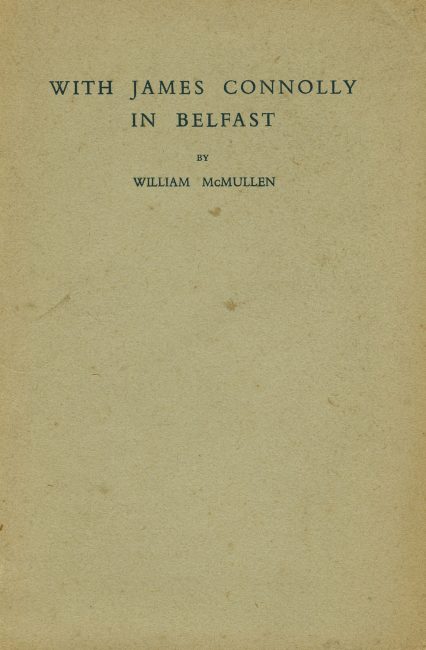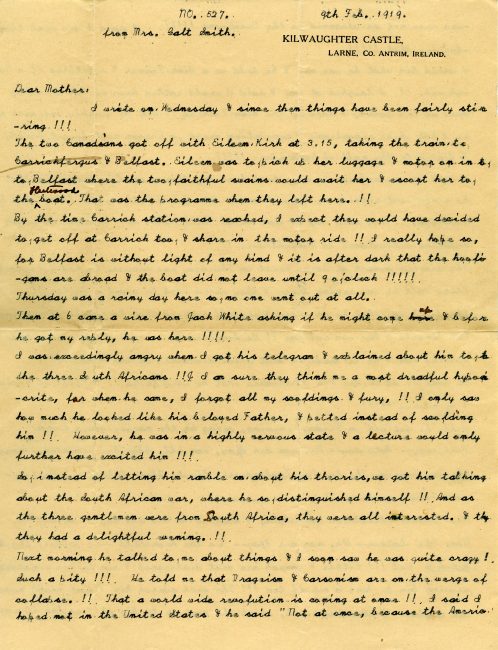Bringhurst III/V, Edward. Photograph of Jack White [in Gibraltar?], circa 1904.
Shipley–Bringhurst–Hargraves family papers
Labor was slow to organize throughout Ireland. Political activity had long tended to focus on economics related to land and agriculture and far less on the plight of the working class. The living conditions of Dublin’s working class in the first decade of the twentieth century were abysmal: crowded and unhygienic tenement conditions fostered and spread disease. Unemployment was rampant due to a worker surplus. Wages were barely half of London’s. James Connolly (1868-1916) began his involvement with the Socialist Party in Scotland in the 1890s. He had grown up very poor in the Irish section of Edinburgh, and socialism became an attractive idea. He formed the Irish Socialist Republican Party (ISRP) in Dublin in 1896 to implement a worker’s republic. He was a prolific writer for American, British and Irish socialist journals including the Worker’s Republic and the Belfast Shan van Vocht, and employed his legendary eloquence on the lecture circuit. He served as James Larkin’s (“Big Jim”) right hand in the Irish Transport and General Workers’ Union (IT&GWU).
In 1913, a group of business owners tried to prevent workers from unionizing with the IT&GWU, with resulting in a strike that involved 300 employers, 20,000 of their workers and 80,000 of the workers’ dependents throughout Dublin from August 1913 to January 1914. Violent clashes between police and strikers were frequent. Larkin himself was beaten and arrested by the Dublin police. The Lock-Out (so termed because the employers locked the workers out for attempting to unionize) petered out as resources and enthusiasm ran low as the months wore on. Larkin left for the United States, and Connolly took over the IT&GWU. He also mobilized the Irish Citizen Army, an armed organization created to allow workers to protect the workers to protect themselves physically from police and spiritually from their plight. Captain Jack White trained and organized the ICA.
At the same time in the northern counties, the Ulster Volunteers were organizing to provide armed resistance to Home Rule. In 1913, the local militia became the Ulster Volunteer Force (UVF). Led by Sir Edward Carson (1854-1935), the protested the Third Home Rule Bill, introduced by Prime Minister H.H. Asquith in 1912. Carson was the first to sign the Ulster Covenant, which defied Home Rule “by any means necessary.” In response, the republicans in the south established the Irish Volunteers, secretly backed by the Irish Republican Brotherhood (IRB).
McMullen, William. With James Connolly in Belfast. [S.l., s.n.]: 19--.
James Connolly (1868-1916) began his involvement with the Socialist Party in Scotland in the 1890s. He had grown up very poor in the Irish section of Edinburgh, and socialism became an attractive idea. He formed the Irish Socialist Republican Party (ISRP) in Dublin in 1896 to implement a worker’s republic. He was a prolific writer for American, British and Irish socialist journals including the Worker’s Republic and the Belfast Shan van Vocht, and employed his legendary eloquence on the lecture circuit. He served as James Larkin’s (“Big Jim”) right hand in the Irish Transport and General Workers’ Union (IT&GWU).
By 1915, Connolly was part of the militant faction of the Irish Volunteers. This group defected from the Volunteers when Irish Parliamentary Party leader John Redmond supported England’s military efforts in World War I, the conscription of Irish soldiers, and the delay of the 1912 Home Rule Bill until after the war.
Connolly took an active part in planning, leading, and commanding the Rising in 1916. He was appointed Military Commander of the Republican Forces in Dublin, which included the Irish Citizens Army. Connolly was one of the seven signatories of the 1916 Proclamation and was in command at the rebels’ headquarters at the General Post Office. He was severely wounded prior to his arrest, and after being found guilty of treason, was sentenced to death. Still wounded, he was tied to a chair in order to face the firing squad. Once known, the manner of his execution caused public outcry and sympathy toward the rebels’ cause.
O’Cathasaigh, P. The story of the Irish citizen army. Dublin and London: Maunsel & Co., Ltd., 1919.
Sean O’Casey (1880-1964) is best known today as a playwright, but he was a fierce nationalist, socialist, and champion of Jim Larkin. He participated in the Dublin Lockout in 1913 and was an active member of the Irish Citizen Army, serving as the ICA’s first secretary and drafting its constitution in 1914. O’Casey was the first Irish playwright to write about the working and poor classes. This is the only work O’Casey published under the Gaelic form of his name.
Galt-Smith, Elizabeth Shipley Bringhurst. Autograph letter to Anna James Webb Bringhurst, February 9, 1919
Shipley–Bringhurst–Hargraves family papers
Elizabeth “Bessie” Galt-Smith was good friends with Lady Amelia and Sir George Stuart White, the parents of Captain James “Jack” White (1879-1946), co-founder of the Irish Citizen Army. The families vacationed together, and Bessie spent time at White Hall in Broughshane. A self-proclaimed misfit (which served as the title of his 1930 autobiography), Jack White was a complex figure, full of contradictions. A decorated soldier of the Second Boer War, White was at various times associated with Roger Casement, Francis Sheehy-Skeffington, Erskine Childers, and Countess Markievicz. He organized Volunteers in Ulster; drilled the Irish Citizen Army; joined Casement in the Home Rule Campaign; and converted to socialism. This slew of seemingly antipodal activity lead Bessie to ask White what “he was now” in this letter.
Bessie informs her mother that Jack White visited her at Kilwaughter, and she found his radicalism to be quite offensive. “I asked him what he was now & he told me a Sinn Féiner & something of a Bolshevik!! I laughed at him & said I would rather hear of his thinking more of his family & less of the Sinn Féiners!! But he quickly informed me that where conscience & conviction moved, a person must forget family & listen to the call of Conscience!!!!! […] The truth is, that he is crazy & so self centered that he thinks of nothing but himself & his own calling!! He imagines he is called on to save the working man & he is really a most awful disturber of the Peace!!!!!”
The envelope in which this letter was sent also bears the censor’s mark. This letter was written shortly after Sinn Féin declared independence from Britain in January 1919.

![Photograph of Jack White [in Gibraltar?], circa 1904 Photograph of Jack White [in Gibraltar?], circa 1904](https://exhibitions.lib.udel.edu/easter1916/wp-content/uploads/sites/15/2019/10/Photograph-of-Jack-White-60.jpg)



